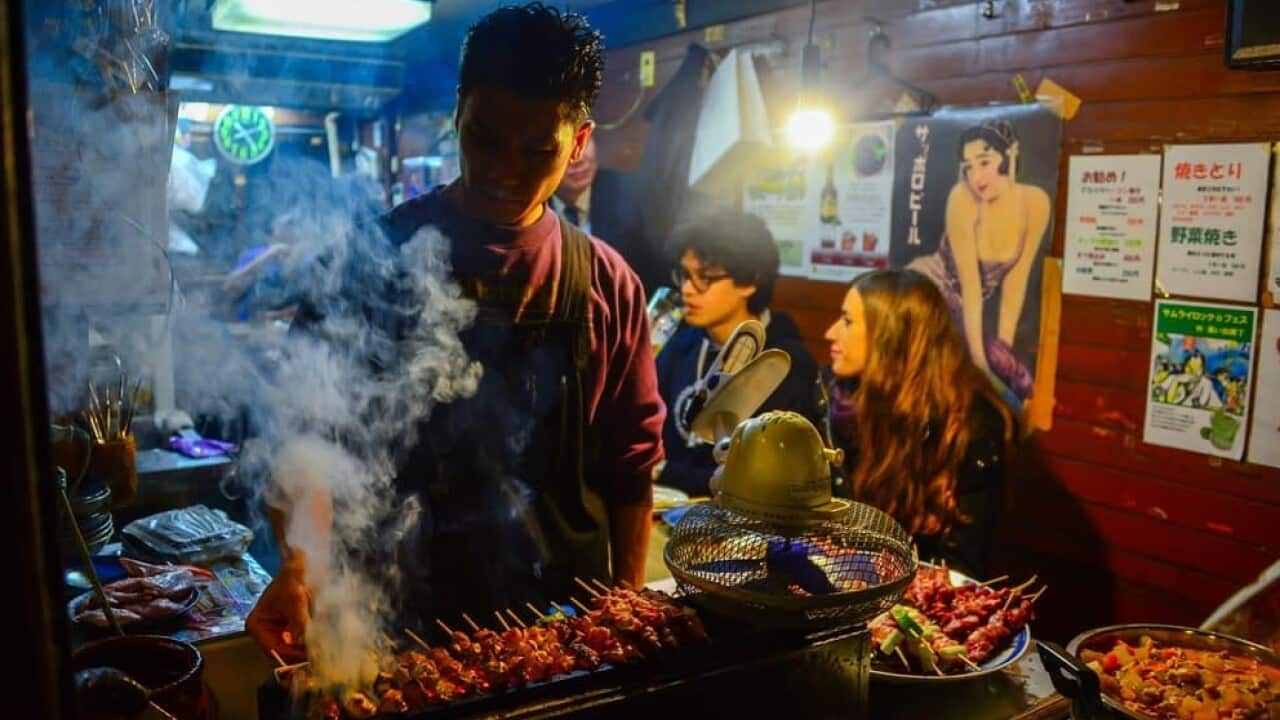When we think of Japanese cuisine as it commonly appears in Australia, a few hero dishes immediately stand out: piping hot, umami-infused ramen laden with roast pork, fresh sashimi sliced with unparalleled precision, and plates piled high with vegetables encased in crunchy, golden tempura batter.
Organ meat (in Japanese, horumon) and pork tongue cooked on the grill, however, may not spark the same kind of fervour – particularly if you haven’t spent time seeking out yakiniku (grilled meats) in the backstreets of Yokohama, Japan. Here in Australia, we haven’t developed a real taste for lesser-known cuts of meat like intestines and gizzards. Japanese authenticity aside, they’re not easy to find in Sydney – unless, of course, you know where to go.
Yokocho is a lifestyle, it’s vibrant, exciting and a fun version of Japanese food and drink culture that doesn’t cost a fortune but always satisfies your cravings and brings a smile to your face.
With his intimate and first-hand experience of (Japan’s thriving street food culture hidden down alleyways) Yokohama-born, Sydney-based chef Kazuki Arai is pushing the boundaries of what Sydneysiders see as ‘real’ Japanese cuisine.
His CBD restaurant, , is charmingly no-frills and mildly chaotic - reminiscent of his grandfather’s dining bar in Yokohama. Everything from the seating (upturned Asahi and Sapporo beer crates) to the menu (pork neck, pork tongue and boneless beef short rib are some of the most popular barbecue options) is as honest as it comes.
“Yokocho is a lifestyle, it’s vibrant, exciting and a fun version of Japanese food and drink culture that doesn’t cost a fortune but always satisfies your cravings and brings a smile to your face,” Arai tells SBS. “It is noisy, crowded and is cluttered but everywhere you look, there’s something interesting to catch your gaze. When I came to Australia, there was nothing like it – I really wanted to bring that experience and all the flavours of yokocho to the country.”
For Arai, this meant serving yakiniku – and all the infrequently used cuts of meat that go with it. “In Japan, some of the most popular barbecue dishes at yakiniku restaurants are horumon, beef tongue, chicken soft bone and other internal organs,” he explains. “It’s an acquired taste, and far from the mainstream popular Japanese barbecue dishes of wagyu. At Yakiniku Yokocho, we’re challenging diners with the truly authentic taste of Japan.”
Tables at traditional yakiniku restaurants are each fitted with a grill at their centre, which is turned on to heat up as diners select various cuts of meat. The meat arrives at the table thinly sliced, usually garnished with little more than salt and pepper – sauces are added after grilling depending on individual tastes.
In Japan, some of the most popular barbecue dishes at yakiniku restaurants are horumon, beef tongue, chicken soft bone and other internal organs.
And then, there are the side dishes, which are just as worthy of the limelight as the main dish. At Yakiniku Yokocho, bowls of ponzu-flavoured chicken skin, lobster salad and miso mackerel balance the singular flavours of the meats, to great effect. Any attempt to limit yourself to one or two sides will be in vain.
If this is sounding a lot like Korean barbecue, it’s because the origins of yakiniku lie in Korea’s arrival to Japan during the mid-20th century Showa period. Initially derived from Korean bulgoli (marinated, thinly sliced meat) and kalbi (marinated beef ribs), the yakiniku tradition has morphed into a Japanese speciality of its own.
It’s a tradition that Arai is trying to champion in Sydney, to the best of his ability. His menu receives a few raised eyebrows from people expecting a more conventional plate of rib eye, sure. But overall, signs point to a continuing evolution in Australians’ relationship to authentic Japanese cuisine.
“Japanese culinary culture in Sydney often focuses on the mainstream, the tried and tested popular dishes like katsu, karaage and teriyaki, whereas Japanese culinary culture in Japan is about exploring new tastes and pushing boundaries with produce, flavours and techniques,” Arai says. “However, Sydney is evolving quickly – it’s becoming more exciting and I think the Australian palate is evolving with it, becoming more and more adventurous. People are more willing to try new things that are beyond their regular comfort levels.”
Next time you’re in the mood for Japanese, bypass the sushi and head straight to Yakiniku Yokocho for a plate of grilled ox tongue and lobster salad – a true taste of yokocho culture.
Shop 9.08, Level 9, 501 George St, Sydney, NSW
Dinner daily
Try something new

Say yes to arepas and Colombian hot chocolate served with mozzarella





